Apple's iPhone 13 Series Screen Power, Battery Life Report - Long Lasting Devices
by Andrei Frumusanu on October 11, 2021 8:30 AM EST- Posted in
- Mobile
- Apple
- Smartphones
- iPhone 13
- Apple A15
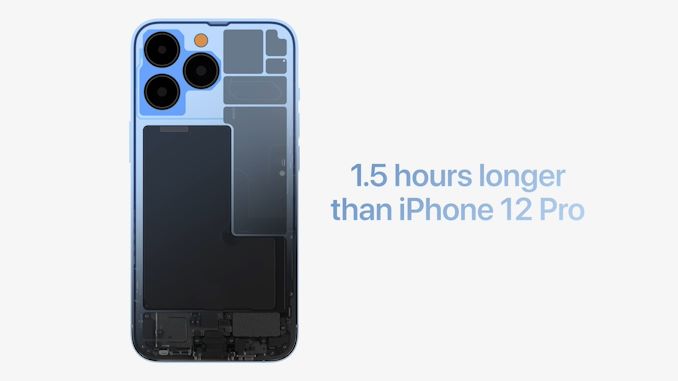
Following our last week’s preview into the new iPhone 13 series’ A15 chip, which impressed us tremendously due to its efficiency gains, we promised next to have a closer look at the new phone’s battery life and how the new display generation and screen efficiency ties in with the SoC efficiency and increased battery capacities this generation.
This year’s new iPhone 13 series have been extremely promising in terms of battery life as Apple has improved this aspect of the devices through a slew of different improvements. All the new phones feature new generation displays, most notably the new Pro models which have new variable refresh displays, along with increases in battery capacities. After a few arduous days of battery life testing, we can come to some very positive conclusions:
LTPO & New OLED Emitters?
Amongst the most notable new technology introductions on this year’s devices has been the addition of “Pro Motion” onto the new iPhone 13 Pro and Pro Max models, essentially high refresh rate displays achieving up to 120Hz. Apple here is also joining the LTPO VRR club, meaning the new phones are introducing variable panel refresh rates, with Apple promising that the new displays vary between 10 and 120Hz in a set of available discrete refresh rates – similar to what we had seen on Samsung’s HOP displays in the Note20 Ultra last year, and the Galaxy S21 Ultra this year.
Beyond the VRR technology, this year’s phones are also getting new more fundamental panel technologies, such as new OLED emitters, allowing for either lower power consumption, or increased maximum peak brightness. To investigate this part more, we revisit our luminance power curves of the various devices to have a better view of what’s happening under the hood.
To avoid confounding display sizes into the mix, we’re limiting the comparison to Apple’s traditionally identical form-factors between generations, starting with the iPhone 11 Pro, followed by both iPhone 12 and 12 Pro generations, and the new iPhone 13 and 13 Pro.
Starting off with what may be somewhat surprising, is the fact that both the iPhone 12 and 13 series have the Pro models consume more power than their non-Pro counterparts. We had skipped this measurement in our review of last year’s phones so this came to a somewhat surprise to me. Measuring the data several times still getting the same results, and regression testing with other power data such as CPU power showed nearly identical figures between the phones, so it wasn’t a difference in methodology. As to why this happens, particularly on the 12 series, isn’t exactly clear to me. There were rumours that the 12 Pro was the first 10-bit display panel from Apple, and this would somehow make sense given the increased power draw over the 12 and 11 Pro models, however we’ve never been able to properly verify this.
On the iPhone 13 series, there’s a few complex behaviours to consider: First off, the iPhone 13 Pro and its LTPO panel noticeable decreases the minimum baseline power consumption of the phone by around a massive 100mW. This isn’t much of a surprise as it’s also what we had experienced on Samsung’s LFD displays – however with the difference that Apple seemingly doesn’t put any restrictions on its low refresh rate drive, so in that regard, Apple is definitely introducing a no-compromise 120Hz VRR implementation here. While 100mW doesn’t sound much, when using the phones at lower screen brightness, this can represent a large percentage of the overall device power consumption, and vastly increase battery life for the new iPhone 13 Pro models.
Secondly, for the regular iPhone 13 model, what I had expected was that Apple would essentially just inherit last year’s iPhone 12 Pro panel and put it into the non-Pro devices this year, as this is how Apple at least has advertised the new phones. However, looking at the power curves here, we see that they’re very different panel generations, with the new iPhone 13 showcasing a noticeable reduction in power that comes associated with a new generation, more efficient OLED emitter material. The jump here is extremely large and compares to the new emitter efficiency bump we’ve seen on the S21 Ultra this year.
Comparing the 13 to the 13 Pro, the phones have quite different curves – while the 13 Pro uses less power to display full white up until 140 nits, the regular 13 becomes more efficient afterwards. We’re also seeing different curve shapes, meaning the phones are driven differently in regards to their PWM and emitter voltages. Without more technical insight, I don’t have any proper explanation for the results, only able to say that they’re consistent.
One more thing to add is the fact that with this year’s Pro models, Apple is finally adding in a dedicated high brightness mode that only works under high ambient brightness. The 13 Pro, in manual brightness mode, will only go up to 853 nits. In auto-brightness mode in a dark environment, the screen will scale up to 625nits, while in a bright environment it offers the full staggering 1059 nits, fulfilling and exceeding the 1000 nit promise that Apple had advertised.
Bigger Batteries
Apple had mentioned the new iPhones lasted longer than their predecessors, but as always this was their own “internal usage metrics” runtime in hours. Physically, the new phones do come with larger batteries, and after the first teardowns, we can get some proper context as to their capacities:
| Apple iPhone 12 vs 13 Battery Capacities | |||||
| mini | "regular" | Pro | Pro Max | ||
| 12 Series | 2227 mAh | 2815 mAh | 2815 mAh | 3687 mAh | |
| 13 Series | 2406 mAh (+8.0%) |
3227 mAh (+14.6%) |
3095 mAh (+9.9%) |
4352 mAh (+18.0%) |
|
The differences here vary depending on the exact model – the 13 mini and 13 Pro gets the smallest increases at +8 and +10% respectively. The regular iPhone 13 sees a larger increase by +14.6%, while the Pro Max definitely sees the largest generational increase at +18% capacity. In terms of absolute capacities, although Apple has increased things by respectable amounts, comparatively speaking, the phones still feature quite minuscule batteries, especially when compared to the Android competition, where a small phone is expected to have at least 4000mAh, and large phones have seemingly standardised around 5000mAh. The new Pro models are also extremely heavy this year, both due to new cameras and the larger batteries – I don’t want to know how much more they would weigh if they had even larger batteries.
The Resulting Battery Life Results
Tying in the SoC efficiency, display efficiency, and larger batteries together, we fall back to our trusted battery life test to investigate the end results. The test consists of varied content of popular sites, with mixed APL, dynamic scrolling, and realistic timings between content loading and reading pauses in-between scrolls.
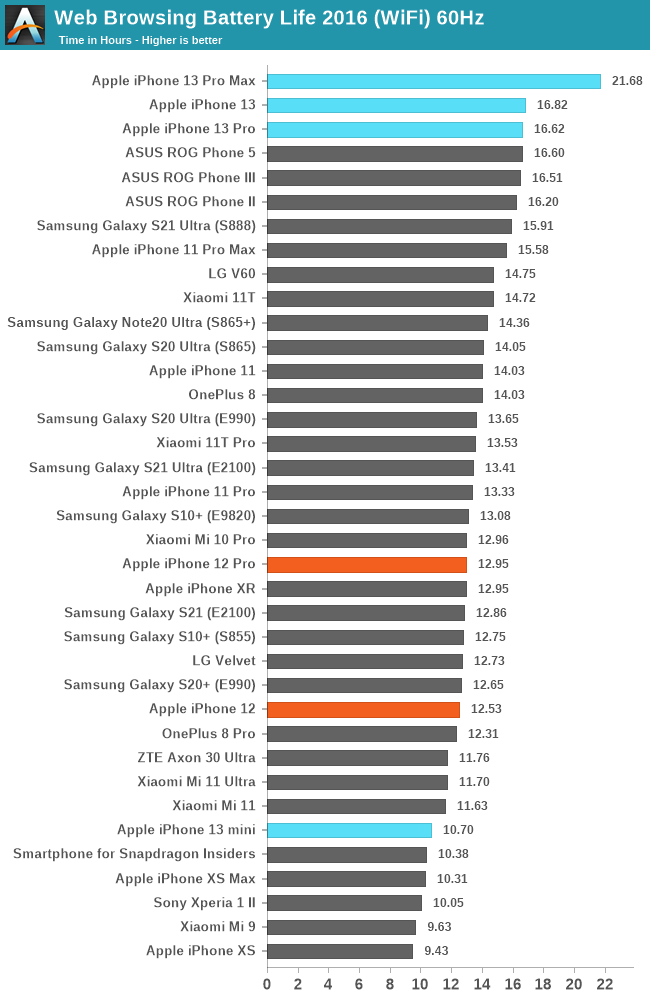
Starting off with the 60Hz results, we can make proper generational comparisons to the iPhone 12 series. As a note, we unfortunately never reviewed the 12 mini or the 12 Pro Max due to the release date discrepancy, so those are missing from the results.
All the new phones showcase extremely large generational gains compared to their predecessors. For the iPhone 13, we’re getting results that are 34% better than the iPhone 12, which exceeds the +14.6% battery capacity increase. The new SoC efficiency as well as increased display power efficiency would explain the remainder of the difference.
The iPhone 13 Pro is tracking in at nearly identical runtime as the 13 – the 4.1% smaller battery of the Pro is slightly compensated by the more efficient display, however what these results show us is that under the same 60Hz refresh rate, the new LTPO screen of the Pro models don’t actually showcase that much of an efficiency advantage over the non-LTPO models – though both have generationally more efficient displays compared to their predecessors.
The iPhone 13 mini showcases adequate battery life at 10.7h, though it’s clearly below-average, though still keeping pace with devices that have massively larger batteries.
The iPhone 13 Pro Max breaks the charts here at 21.68 hours. We’re missing the 12 Pro Max, but it’s significantly longer than the 11 Pro Max, as well as the 6000mAh ASUS ROG Phone monsters, and also significantly ahead of the S21 Ultras which also have larger batteries.
Apple’s 120Hz refresh rate seems to work very similarly to Samsung’s LFD VRR, in that the display can vary itself between a few discrete refresh rates, ranging from 120Hz through 80, 60Hz, and a few other low frequency refresh rates down to 10Hz. The frequencies presented by Apple are similar to what Samsung exposes in its drivers, which wouldn’t be surprising if they’re both based on the same panel technology.
Apple’s practical implementation has some OS side differences though, one thing that I noted is that within browser content, although scrolling through the viewport happens at 120Hz, actual content animations seem to be limited to 60Hz. This is a difference to current Android devices which also render content animations at 120Hz. I don’t think this is of any practical difference in experience, however interesting. Otherwise, Apple’s Pro Motion on iPhones seems to work very well and without issues.
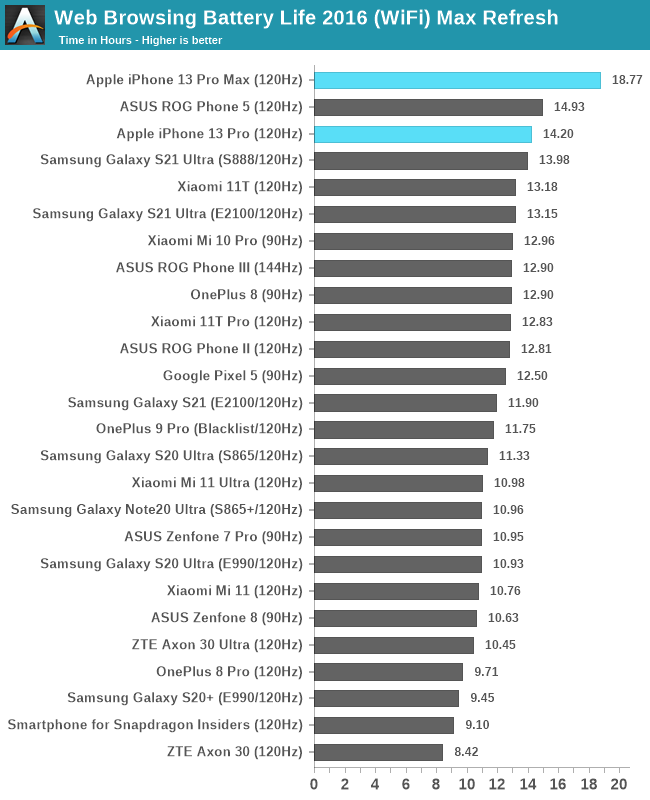
In the 120Hz result set, for which the new iPhone 13 Pro models are now the first Apple devices amongst the competition, the new phones directly introduce themselves as top performers.
The iPhone 13 Pro and 13 Pro Max lose respectively 14.5% and 13.5% over their 60Hz results which is generally in line with the 12.2% degradation the S21 Ultra sees – you can argue if Apple’s 60Hz is more efficient than Samsung’s or if Samsung’s 120Hz is more efficient than Apple’s, the difference remains small.
Given the much smaller battery of the 13 Pro Max, seemingly similar display technology and efficiency to the S21 Ultra, Apple’s battery life advantage remains in my opinion squarely on the massive efficiency advantages of Apple’s silicon, with the new A15 further increasing this discrepancy compared to the competition.
Battery Life Kings
Today’s investigation into the battery life results of the new iPhone 13 series confirms what many others have already mentioned already – it’s a significant upgrade over the iPhone 12 generation, with vast increases across the board. Apple’s new more efficient displays, larger batteries, as well as notably more efficient A15 chip represent a holy trifecta of hardware characteristic improvements that is extremely positive to the longevity of the new phones. There’s little more left to be said.


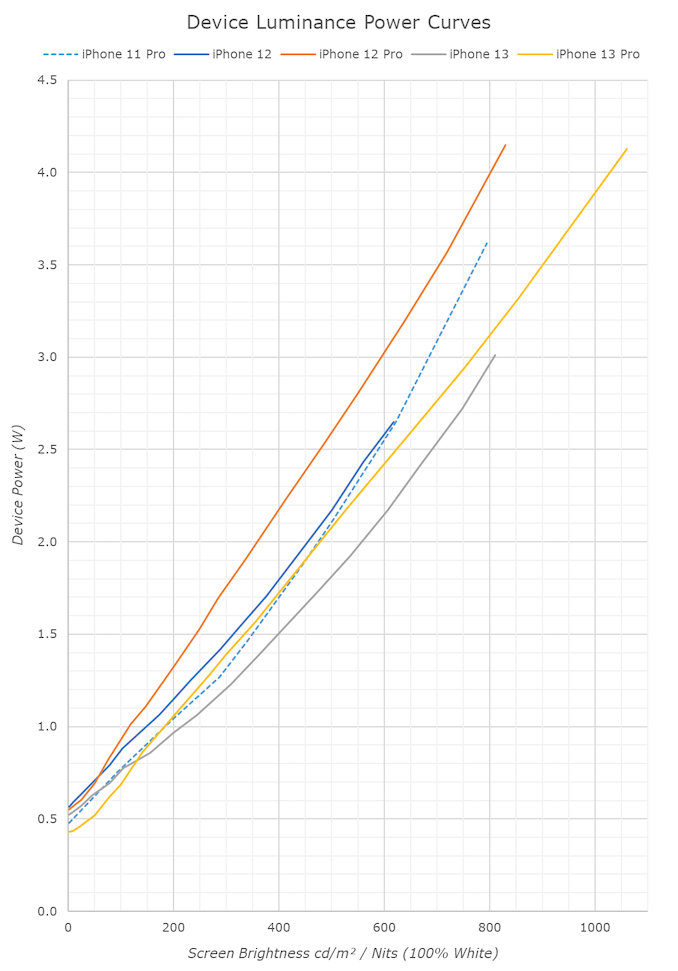
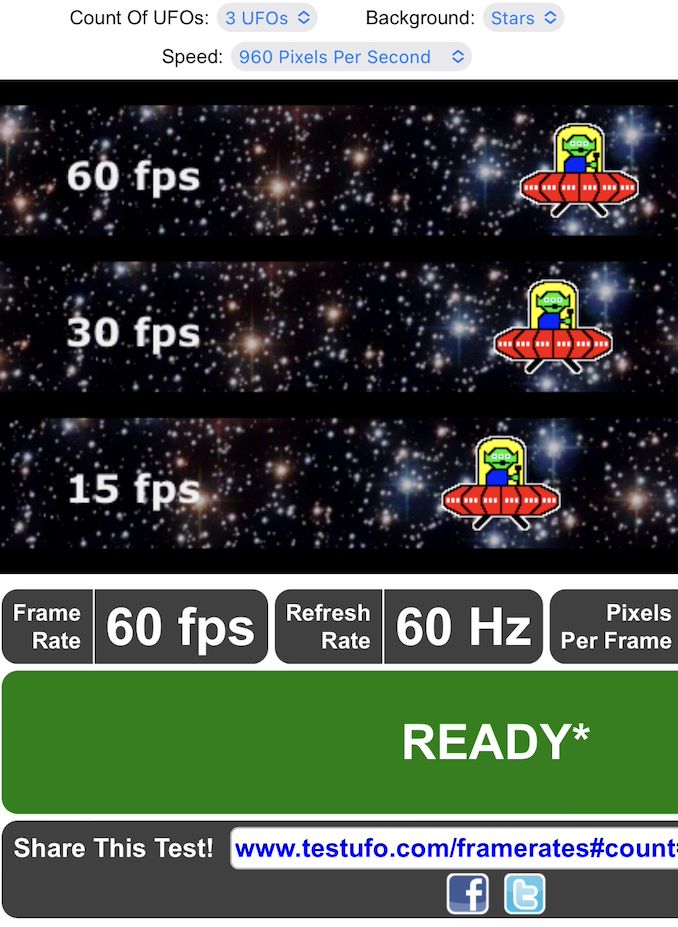








83 Comments
View All Comments
mmrezaie - Monday, October 11, 2021 - link
The damn thing is I tested the screen on these new iPhones. Now, I cannot unsee the choppiness of 60fps screens. I was just going to order a new monitor for my office! It is a big deal this screen for my eyes.jospoortvliet - Wednesday, October 13, 2021 - link
Fascinating how big a deal it is for some people. I don't see the difference of my iPad pro vs my 60hz desktop monitor. Maybe if I had a 120 and 60 hz monitor next to each other- maybe. I can clearly see 30-60, though...Dex4Sure - Saturday, October 16, 2021 - link
Most of these people are highly emotional. I see the difference, but I simply don't care. I don't obsess over what refresh rate my monitor is lmao. I have 120hz and 60hz screens side by side, sure 120hz is bit smoother but most greatly exaggerate the difference.arrowthefirst - Saturday, October 16, 2021 - link
why not just disabling 120 Hz on the iphone? it's much smarter: you will get more battery life on all of your devices and you won't have to buy the new monitor.Except for cybersports, more Hz don't give any advantage, enough said
FickleBJT - Tuesday, November 9, 2021 - link
I've had the same experience! I got the 13 Pro and now my other screens feel so choppy. One thing that's super nice with the higher refresh rate is that I can actually read text as it's scrolling (up to a certain speed at least). On all of my other monitors, even slightly-moving text becomes a blurry mess. It's so much easier to track words in articles as I scroll through them.shabby - Monday, October 11, 2021 - link
Top notch hardware... the os on the other hand just isn't my type.Kangal - Monday, October 11, 2021 - link
I think the OS is fine/great. In fact, it's more efficient and better than Android.What people despise about iOS is much less about the code, and more so about it's arbitrary restrictions like AppStore, API limitations, etc etc. Those have less to do with the quality, technology, and merits of the Operating System, and more to do with the Policies that the organisation imposes on its users.
shabby - Monday, October 11, 2021 - link
That's exactly what I don't like about it.TheinsanegamerN - Tuesday, October 12, 2021 - link
More efficient? Yes. Better? That's highly subjective.I for one absolutely hate how iOS does their drop down menus and their notifications. And as you mentioned all the lockdowns are a part of iOS.
jospoortvliet - Wednesday, October 13, 2021 - link
IMHO it has pros and cons. I don't like how most settings are not in apps - I am always looking for them. But it generally is a painless os, then again android works fine too.